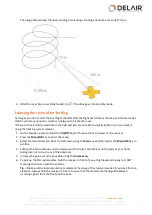
Abort
Note –
The
button is available only during the final leg of the landing when the aircraft is more than 15
m (49 ft) above ground. Make sure you consider the obstacle clearances for the Abort manoeuvre before
you tap
. For more information, see
Use the
button to abort the landing.
When you tap
, the rover climbs to 75 m (246 ft) in the direction of the landing heading and then turns to
the landing entry point to start the landing circuit again.
To land you must tap
in the message box on the map again.
Handling emergencies during flight
If evasive action is required, you can manually interrupt the pre-programmed flight plan while the rover is in
the air.
For all emergencies, you must assess the situation before taking action. Take into account the takeoff
location, the current location, course, and speed of the rover.
Note –
If the situation is
too critical
(for example, fast moving aircraft) tap
and when prompted
confirm Flight Termination System (FTS) activation to
immediately abort the flight
and put the rover in
an orbit toward the ground.
An approaching aircraft
The most common emergencies involve another aircraft entering the vicinity at approximately the same
height as the rover.
Scenario
Action
The approaching aircraft
will not cross
the flight path
of the rover.
1. Assess the situation.
2. Tap
,
,
, or
to move the rover to a safe position.
The flight path of the approaching aircraft
and the rover are
converging
.
1. Assess the situation.
2. Tap
to move the rover to a safe position.
The flight path of the approaching aircraft
is
diverging
from the flight path of the
rover.
1. Assess the situation.
2. Tap
,
, or
to move the rover to a safe position.
The flight path of the approaching aircraft
is
intercepting
the flight path of the
rover.
1. Assess the situation.
2. Tap
to move the rover to a safe position. (An aircraft
intending to overtake an aircraft in front of them
overtakes that plane on the right side.)
The approaching aircraft is approaching
the rover
head-on
.
1. Assess the situation.
2. Tap
to move the rover to a safe position.
The approaching aircraft intends to land. A landing aircraft has priority over an rover at all times. Never
assume that the aircraft has noticed the rover. Take the
necessary safety measures depending on the situation.
When the other aircraft has left the vicinity, tap the emergency button again to cancel the pattern and
continue mapping.
91
Delair-Tech
|
676, Rue Max Planck – 31670 Toulouse-Labège, France
|
Tel: +33 (0) 5 82 95 44 06
|
Capital: 238 110,30 € - APE: 3030Z – Intra-Community VAT number: FR90 53 09 69 781 – 530 969 781 R.C.S. Toulouse
This document is the sole property of Delair-Tech and cannot be used or reproduced without the written authorization of Delair-Tech
.













































